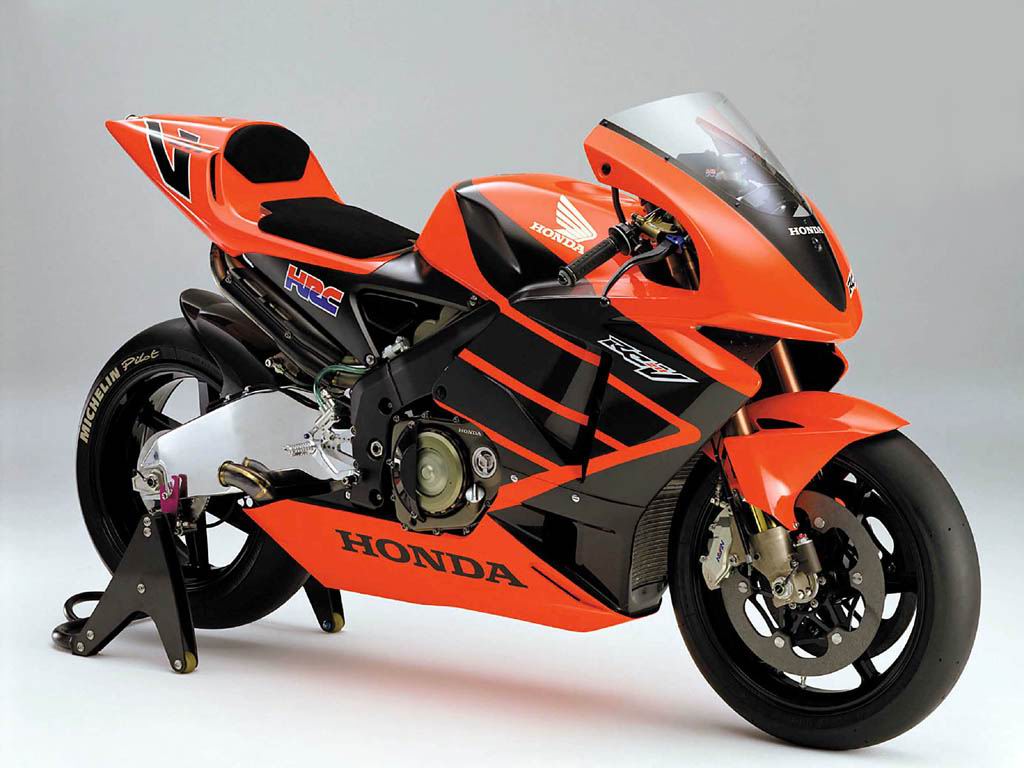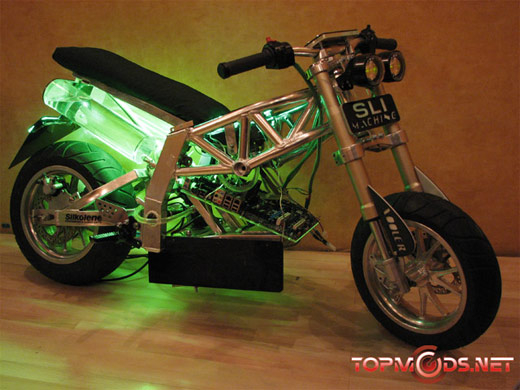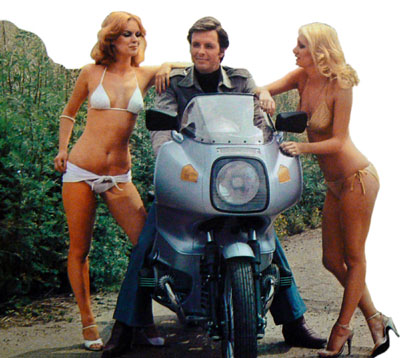Preparation
Memorable races match two top rivals of comparable skill and equal valour, driven by the need to succeed, riding machines at the leading edge of performance, backed by well-drilled and determined teams. The Isle of Man Tourist Trophy provides the perfect setting to test man and machine, with challenges of the timed interval start, the mountain climb and weather, and the
 ordinary rural roads. In my opinion, the “Greatest TT race”, the Senior TT of 1935, brought all this together to provide one of the epic races of all time. But the story of this race really began in 1933.
ordinary rural roads. In my opinion, the “Greatest TT race”, the Senior TT of 1935, brought all this together to provide one of the epic races of all time. But the story of this race really began in 1933.Stanley Woods, a Dubliner and rider of outstanding talent (on any form of motorcycle), began his TT career in 1922 as a precocious 17-year-old. Initially he combined riding with his work as a salesman for the sweet makers Mackintosh’s. In the following years Woods would provide boxes of toffees (from a business with his father) for the boy scouts that ran the leader board at the TT. He won his first TT (the
 Junior - see top pic) in 1923 on a Cotton, then moved to Norton in 1926 (see pic 2) and won the Senior TT that year (thus beginning a string of wins for Norton which included the Junior and Senior TTs in 1932 and 1933. By 1933 Norton had established such supremacy that winning a race was called “the Norton Habit”, and the team began to allocate wins to particular riders on their team. 'Team orders' did not suit Woods, who was the star rider for Norton. By the early 1930’s, motorcycling had become a professional sport and Woods, now at his peak, relied on wins and retainers to make his living; he decided to leave Norton. For the 1934 TT he was retained to ride the 500cc v-twin Husqvarna, (pic 3)designed by Folke Mannerstedt - light and
Junior - see top pic) in 1923 on a Cotton, then moved to Norton in 1926 (see pic 2) and won the Senior TT that year (thus beginning a string of wins for Norton which included the Junior and Senior TTs in 1932 and 1933. By 1933 Norton had established such supremacy that winning a race was called “the Norton Habit”, and the team began to allocate wins to particular riders on their team. 'Team orders' did not suit Woods, who was the star rider for Norton. By the early 1930’s, motorcycling had become a professional sport and Woods, now at his peak, relied on wins and retainers to make his living; he decided to leave Norton. For the 1934 TT he was retained to ride the 500cc v-twin Husqvarna, (pic 3)designed by Folke Mannerstedt - light and powerful, but thirsty.
powerful, but thirsty.Jimmie Guthrie was from Hawick in Scotland, where he ran a successful motor business with his brother Archie. A survivor of the horrific 1915 Quintinshill troop train rail crash near Gretna, he served in Gallipoli and Palestine, then as a dispatch rider at the Somme and Arras. Guthrie had come into professional motorcycle racing in his late 20’s, competing in his first TT in 1923 (the year of Woods’ first win). Four years later he returned as a regular competitor on a New Hudson (see pic 4); he finally got a works ride with the Norton Team in 1931.
 Guthrie was well aware that he was older than other competitors, and he had a vigorous training programme to keep fit. Guthrie took over as the lead rider for Norton at the end of 1933 (after Woods left), and immediately showed he was on top of his form. He made his mark winning the 1934 Junior AND Senior TTs (pic 5). The latter after a strong challenge to the Norton team from Stanley Woods. That challenge failed on the last lap with a spill at Ramsay Hairpin followed by the Husqvarna running of fuel 8 miles from the finish. Still, ‘the foreign menace’, the feared TT success of European motorcycle manufacturers, was at the doorstep.
Guthrie was well aware that he was older than other competitors, and he had a vigorous training programme to keep fit. Guthrie took over as the lead rider for Norton at the end of 1933 (after Woods left), and immediately showed he was on top of his form. He made his mark winning the 1934 Junior AND Senior TTs (pic 5). The latter after a strong challenge to the Norton team from Stanley Woods. That challenge failed on the last lap with a spill at Ramsay Hairpin followed by the Husqvarna running of fuel 8 miles from the finish. Still, ‘the foreign menace’, the feared TT success of European motorcycle manufacturers, was at the doorstep.
By 1935, the Norton team was a well-oiled TT-winning machine, with ‘the Fox’ Joe Craig (and his system of signalling riders around the course) in charge. Norton's racing bikes, based on their Models 30 and 40 International, were the best in the business. These machines were developed when Walter Moore designed a powerful ohc, single cylinder engine in 1926 (see pic 6) for
 Norton (Moore used Chater Lea ohc machines for reference; Stanley Woods said impishly that Moore chose the wrong engine to copy!). Though the engine was an immediate winner, it was initially unreliable, and was redesigned and improved in 1929 by Arthur Carroll and Joe Craig. (pic 7- this is Guthrie's 1935 TT bike). The 500c engine probably was developing a reliable 35-38 bhp by 1935 (sadly the year Arthur Carroll died in a crash while riding his fast ‘tweaked’ side-valve Norton). The TT Norton had excellent handling, though it still used a rigid frame with girder forks. The whole package was refined with an emphasis on lightness. Velocette was still in its wilderness years: it had pioneered the ohc single successfully at the TT in the late 1920’s but had lost its way at the top level on frame design and brakes.
Norton (Moore used Chater Lea ohc machines for reference; Stanley Woods said impishly that Moore chose the wrong engine to copy!). Though the engine was an immediate winner, it was initially unreliable, and was redesigned and improved in 1929 by Arthur Carroll and Joe Craig. (pic 7- this is Guthrie's 1935 TT bike). The 500c engine probably was developing a reliable 35-38 bhp by 1935 (sadly the year Arthur Carroll died in a crash while riding his fast ‘tweaked’ side-valve Norton). The TT Norton had excellent handling, though it still used a rigid frame with girder forks. The whole package was refined with an emphasis on lightness. Velocette was still in its wilderness years: it had pioneered the ohc single successfully at the TT in the late 1920’s but had lost its way at the top level on frame design and brakes.The 500cc challenge in 1935 came from Moto Guzzi and their 120-degree v-twin sohc-engined bike. We again return to 1933. While successful at 250cc in ‘Lightweight’ racing, Moto Guzzi were no longer competitive in the larger classes. In 1933 Carlo Guzzi (no doubt encouraged by his partner and racing enthusiast Giorgio Parodi) had the inspiration to mate two 250cc engines to create the 'bicilindri'. The magazine MotorCycling in 1935 describes the enigine as having an even 'beat'. A cutaway drawing from 1951 (the last year of the 'bicilindri') shows, in effect, two 250cc engines, each with its own flywheels and crankpins, joined through a central main bearing (with the crankpins set 120 degrees apart, hence the even beat). Carlo really had joined together two 250cc engines! The front cylinder remained horizontal with the rear cylinder laid back and with circumferential fins added. Importantly, the bike had a sprung rear frame using springs in compression, and friction dampers that could be adjusted ‘on-the-run’,
 by a lever on the front left hand side (last pic - note large handwheel near the front of the tank); Brampton girder front forks were used. By 1935 the engine was reliable and able to produce 44/45 bhp at 7000rpm (in super-tuned form up to 50 bhp at 7500rpm was claimed). But like the Husqvarna, it was thirsty. Moto Guzzi were confident they had a bike that could win the TT, but required a rider with proven TT winning experience to have any chance of success. They found their man in Stanley Woods: it was rumoured he was allowed to state his own price and of course Stanley Woods had a point to make!
by a lever on the front left hand side (last pic - note large handwheel near the front of the tank); Brampton girder front forks were used. By 1935 the engine was reliable and able to produce 44/45 bhp at 7000rpm (in super-tuned form up to 50 bhp at 7500rpm was claimed). But like the Husqvarna, it was thirsty. Moto Guzzi were confident they had a bike that could win the TT, but required a rider with proven TT winning experience to have any chance of success. They found their man in Stanley Woods: it was rumoured he was allowed to state his own price and of course Stanley Woods had a point to make!The final component in the equation was the TT circuit itself. For both the 1934 and 1935 races improvements had been made to the circuit to remove bottlenecks. It was now a ‘modern’ road-racing circuit allowing riders to run their bikes to the limit.
Motorcycling magazine promoted the lead-up to the TT and its prospects. With the darkest period of the depression lifting, at least in some places, there was much enthusiasm for the TT and promotion of tourist travel. The 1935 TT races were also the backdrop to the (third) George Formby film ‘No Limit’ and his heroics on the ‘Shuttleworth Snap’.

In practice for the Senior TT, Norton preparation was developed to new levels. But in the background there were reports of high speeds from the Moto Guzzi, including an unofficial lap record on the last day of practice . Then, Stanley Woods won the Lightweight TT on a 250cc horizontal single Moto Guzzi, a first for a foreign bike: the ‘foreign menace’ had arrived.
Photo Sources: 'The Keig Collection' (BMS '84), 'The Unnaproachable Norton' (B. Holliday, '79, Beaulieu Books), 'Moto Guzzi da Corsa, Vol 1' (S. Colombo, '95, NADA), 'Jimmie Guthrie' (G.Small, '97, Hawick Arch. Soc.), 'Stanley Woods' (W.F. McCleery, '87, Ulster Folk&Transport Mus.)









No comments:
Post a Comment